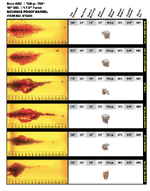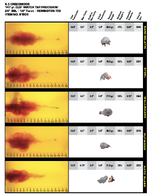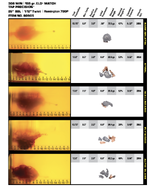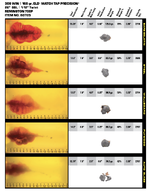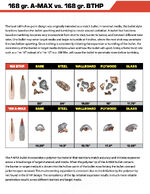Goal: Make as objective as In-Flight Ballistics for Hunting.
Confirmed:
Bullet carries energy and does ‘work’.
Confirmed:
We don’t know how to measure the work after impact but we do know how to measure it before impact.
Work is applied to Bullet by way of pressure (controlled explosion), the work is used to overcome barrel drag and then air drag to get to the target. Once at the target the remaining work potential is then applied…
In-Flight Ballistics: (start at the start)
What the Constants and Variables are and how did we solve them?
Constants:
• Bullet (BC)
• Gravity (vertical, easily measured and applied)
Variables:
• Air (Temp, Pressure, Humidity, Velocity)
To get the Bullet constant solved for or created, which is ballistic coefficient (BC), we had to first learn how to measure the Air and there’s not just a multitude of sensors we created to measure the Air but multiple types to measure each variable. Some Sensor Examples; Thermistors, Thermocouples, RTD’s, Resistive, Thermal Conductivity, Piezoresistive, Aneroid Barometers (thanks AI). Once we measured the Air then we also learned how to measure the bullet speed through the Air by way of time of flight, chronographs, radar and whatever technologies and sensors present within those tools which are also numerousand technical marvels, from taking snap shot of speed at static location of the bullet or measure entire bullet flight.
With Air variables solved for, combined with velocity, we could come up with the BC as the constant for the Bullet. Which then allows us to measure Air and input conditions, along with BC,into handheld computers to accurately place shots as far as bullet will fly before gravity pulls it into the dirt. Now we carry devices that will measure the air variables and calculate solutions in one unit at the push of a button. We’ve come a long way in In-Flight ballistics and seemingly as far as we need to go as we can place bullets as far as they will fly but we didn’t get here overnight. We will continue to improve the accuracy of the instruments and calculators to improve our accuracy down range. This has been evolving and improving for decades.
Difference between Inflight & Terminal Ballistics: (Constants & Variables)
Constants:
• Gel (to represent flesh)
Variables:
• Bullet (Sectional Density ‘SD’)
The Constants and Variables flip in Terminal Ballistics. Now theremaining work ‘potential’ is applied completely through a far more dense constant than Air and over a very short distance.Dense enough that the Bullet changes in shape, and or, mass Thesectional density changes rapidly (exception being solids/fmj’s).The constant(gel) shows a visual representation of the applied work but is only a representation that we’ve always tried to measure by way of linear length measurements, not work measurements.
What needs to happen now is to learn how to measure the velocity in gel along with change in shape/mass (SD), for the full travel in the gel. This will give us a work curve at a single impact velocity. And then we need to do it at all usable impact velocity ranges. We may have to determine how frequently those intervals need to be to get usable data, such as every 1000 fps, or 500 fps, or 200 fps etc.? It’s only from this point can we then possibly get usable data that could end up translating into a single number that could represent ‘rate of change’ or ‘work transfer rate’ such as BC is for In-Flight. Data tells the story,more data tells the story more accurately. It would evolve to see how much data we need to be useful, maybe every 500 fps intervals for curves is enough, in time as we advance the accuracy and development we may end up every 100 fps? Too early to tell as we aren’t looking at anything but gel pictures at near useless muzzle velocities. We are going to need some new tools to do this (sensors etc.).
I can see what’s missing, but it will take a team to build the tools(sensors) and another team to apply them to obtain the data,then a data team to crunch the data and make it useful (ie; BC),and then the final team that makes the calculators for end users (all Hunters).
Everything else we talk about in these threads is pointless aside from it pointing out what we’re missing IF the goal is to make this objective and as good as In-Flight for predicting performance down range. Placement, measuring result of workat random impact velocities, calling each other dumb, and every other unrelated thing that comes into these discussions. We’re not dumb, we’re just missing information to make this easier for everyone to understand and compare. We’ve been looking at theresult of work instead of the work itself. We got the cart ahead of the horse. The bullet does the work, need to measure the bullet as it does the work.
Arguing how much theoretical, and or, imaginary ‘result of work’ is being done between bullets, based on subjective experiences and crude measurements. That has not, and will not,help us to stop doing that. Choose your rapid controlled expansion horse with enough sd already proven to kill by others and away you go…that’s as far as you can take it. Or choose your delayed controlled expansion horse with whatever sdproven to work for game classes and eat to the hole…easy. We waste our time doing anything else at this point.
You can’t make people understand, you can help, and some of us give more than others in effort but at some point…omfg sets in and you have to just go get a drink. We’ve hit that point about 8 times in this 27 pages so far lol.

